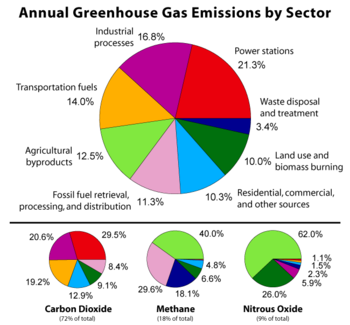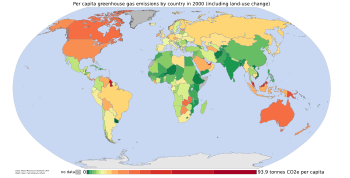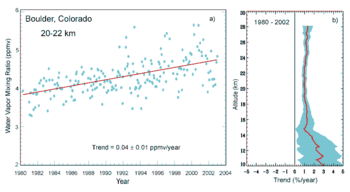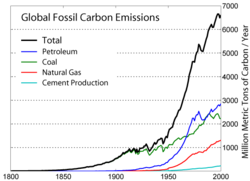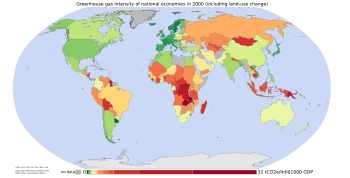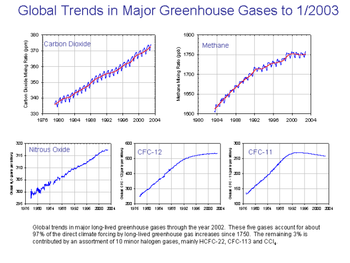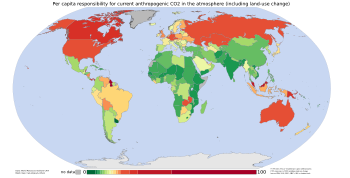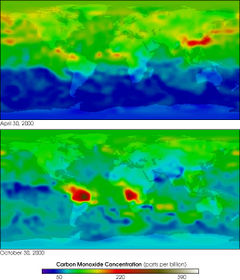Greenhouse gas
2008/9 Schools Wikipedia Selection. Related subjects: Climate and the Weather
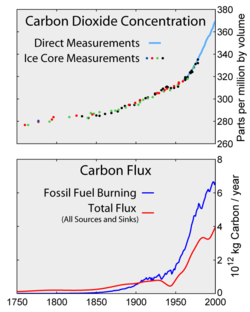
Greenhouse gases are components of the atmosphere that contribute to the greenhouse effect. Without the greenhouse effect the Earth would be uninhabitable; in its absence, the mean temperature of the earth would be about −19 °C (−2 °F, 254 K) rather than the present mean temperature of about 15 °C (59 °F, 288 K). Greenhouse gases include in the order of relative abundance water vapour, carbon dioxide, methane, nitrous oxide, and ozone. Greenhouse gases come from natural sources and human activity.
The "greenhouse effect"
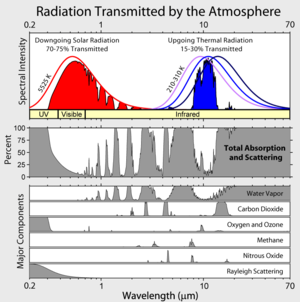
When sunlight reaches the surface of the Earth, some of it is absorbed and warms the surface. Because the Earth's surface is much cooler than the sun, it radiates energy at much longer wavelengths than the sun does, peaking in the infrared at about 10µm. The atmosphere absorbs these longer wavelengths more effectively than it does the shorter wavelengths from the sun. The absorption of this longwave radiant energy warms the atmosphere; the atmosphere also is warmed by transfer of sensible and latent heat from the surface. Greenhouse gases also emit longwave radiation both upward to space and downward to the surface. The downward part of this longwave radiation emitted by the atmosphere is the "greenhouse effect." The term is a misnomer, as this process is not the mechanism that warms greenhouses.
The major greenhouse gases are water vapor, which causes about 36–70% of the greenhouse effect on Earth ( not including clouds); carbon dioxide, which causes 9–26%; methane, which causes 4–9%, and ozone, which causes 3–7%. It is not possible to state that a certain gas causes a certain percentage of the greenhouse effect, because the influences of the various gases are not additive. (The higher ends of the ranges quoted are for the gas alone; the lower ends, for the gas counting overlaps.) Other greenhouse gases include, but are not limited to, nitrous oxide, sulfur hexafluoride, hydrofluorocarbons, perfluorocarbons and chlorofluorocarbons (see IPCC list of greenhouse gases).
The major atmospheric constituents ( nitrogen, N2 and oxygen, O2) are not greenhouse gases. This is because homonuclear diatomic molecules such as N2 and O2 neither absorb nor emit infrared radiation, as there is no net change in the dipole moment of these molecules when they vibrate. Molecular vibrations occur at energies that are of the same magnitude as the energy of the photons on infrared light. Heteronuclear diatomics such as CO or HCl absorb IR; however, these molecules are short-lived in the atmosphere owing to their reactivity and solubility. As a consequence they do not contribute significantly to the greenhouse effect.
Late 19th century scientists experimentally discovered that N2 and O2 did not absorb infrared radiation (called, at that time, "dark radiation") and that CO2 and many other gases did absorb such radiation. It was recognized in the early 20th century that the known major greenhouse gases in the atmosphere caused the earth's temperature to be higher than it would have been without the greenhouse gases.
Anthropogenic greenhouse gases
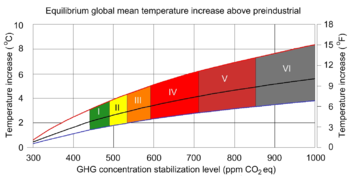
The concentrations of several greenhouse gases have increased over time. Human activity may increase the greenhouse effect through release of carbon dioxide, but human influences on other greenhouse gases can also be important. Some of the main sources of greenhouse gases due to human activity include:
- burning of fossil fuels and deforestation leading to higher carbon dioxide concentrations;
- livestock and paddy rice farming, land use and wetland changes, pipeline losses, and covered vented landfill emissions leading to higher methane atmospheric concentrations. Many of the newer style fully vented septic systems that enhance and target the fermentation process also are major sources of atmospheric methane;
- use of chlorofluorocarbons (CFCs) in refrigeration systems, and use of CFCs and halons in fire suppression systems and manufacturing processes.
- agricultural activities, including the use of fertilizers, that lead to higher nitrous oxide concentrations.
The seven sources of CO2 from fossil fuel combustion are (with percentage contributions for 2000–2004):
- Solid fuels (e.g. coal): 35%
- Liquid fuels (e.g. gasoline): 36%
- Gaseous fuels (e.g. natural gas): 20%
- Flaring gas industrially and at wells: <1%
- Cement production: 3%
- Non-fuel hydrocarbons: <1%
- The "international bunkers" of shipping and air transport not included in national inventories: 4%
The U.S. EPA ranks the major greenhouse gas contributing end-user sectors in the following order: industrial, transportation, residential, commercial and agricultural. Major sources of an individual's GHG include home heating and cooling, electricity consumption, and transportation. Corresponding conservation measures are improving home building insulation, compact fluorescent lamps and choosing high miles per gallon vehicles.
Carbon dioxide, methane, nitrous oxide and three groups of fluorinated gases ( sulfur hexafluoride, HFCs, and PFCs) are the major greenhouse gases and the subject of the Kyoto Protocol, which entered into force in 2005.
CFCs, although greenhouse gases, are regulated by the Montreal Protocol, which was motivated by CFCs' contribution to ozone depletion rather than by their contribution to global warming. Note that ozone depletion has only a minor role in greenhouse warming though the two processes often are confused in the popular media.
The role of water vapor
Water vapor is a naturally occurring greenhouse gas and accounts for the largest percentage of the greenhouse effect, between 36% and 66% . Water vapor concentrations fluctuate regionally, but human activity does not directly affect water vapor concentrations except at local scales (for example, near irrigated fields).
Current state-of-the-art climate models include fully interactive clouds. They show that an increase in atmospheric temperature caused by the greenhouse effect due to anthropogenic gases will in turn lead to an increase in the water vapor content of the troposphere, with approximately constant relative humidity. The increased water vapor in turn leads to an increase in the greenhouse effect and thus a further increase in temperature; the increase in temperature leads to still further increase in atmospheric water vapor; and the feedback cycle continues until equilibrium is reached. Thus water vapor acts as a positive feedback to the forcing provided by human-released greenhouse gases such as CO2.
Greenhouse gas emissions
Measurements from Antarctic ice cores show that just before industrial emissions started, atmospheric CO2 levels were about 280 parts per million by volume (ppm; the units µL/L are occasionally used and are identical to parts per million by volume). From the same ice cores it appears that CO2 concentrations stayed between 260 and 280 ppm during the preceding 10,000 years. Studies using evidence from stomata of fossilized leaves suggest greater variability, with CO2 levels above 300 ppm during the period 7,000–10,000 years ago, though others have argued that these findings more likely reflect calibration/contamination problems rather than actual CO2 variability.
Since the beginning of the Industrial Revolution, the concentrations of many of the greenhouse gases have increased. The concentration of CO2 has increased by about 100 ppm (i.e., from 280 ppm to 380 ppm). The first 50 ppm increase took place in about 200 years, from the start of the Industrial Revolution to around 1973; the next 50 ppm increase took place in about 33 years, from 1973 to 2006. PDF (96.8 KiB). Many observations are available on line in a variety of Atmospheric Chemistry Observational Databases. The greenhouse gases with the largest radiative forcing are:
| Gas | Current (1998) Amount by volume | Increase over pre-industrial (1750) | Percentage increase | Radiative forcing ( W/ m²) |
|---|---|---|---|---|
| Carbon dioxide |
|
|
|
|
| Methane |
|
|
|
|
| Nitrous oxide |
|
|
|
|
| Gas | Current (1998) Amount by volume |
Radiative forcing (W/m²) |
|---|---|---|
| CFC-11 |
|
|
| CFC-12 |
|
|
| CFC-113 |
|
|
| Carbon tetrachloride |
|
|
| HCFC-22 |
|
|
(Source: IPCC radiative forcing report 1994 updated (to 1998) by IPCC TAR table 6.1 ).
Recent rates of change and emission
The sharp acceleration in CO2 emissions since 2000 of >3% y−1 (>2 ppm y−1) from 1.1% y−1 during the 90's is attributable to the lapse of formerly declining trends in carbon intensity of both developing and developed nations. Although over 3/4 of cumulative anthropogenic CO2 is still attributable to the developed world, China was responsible for most of global growth in emissions during this period. All this indicates a global failure to decarbonise energy supply and an underestimation of emissions growth on the part of the IPCC in their Special Report on Emissions Scenarios. Localised plummeting emissions associated with the collapse of the Soviet Union have been followed by slow emissions growth in this region due to more efficient energy use, made necessary by the increasing proportion of it that is exported. In comparison, methane has not increased appreciably, and N2O by 0.25% y−1 .
Asia
Atmospheric levels of the main greenhouse gas have set another new peak in a sign of the industrial rise of Asian economies led by China.
United States
The United States emitted 16.3% more GHG in 2005 than it did in 1990. According to a preliminary estimate by the Netherlands Environmental Assessment Agency, the largest national producer of CO2 emissions since 2006 has been China with an estimated annual production of about 6200 megatonnes. It is followed by the United States with about 5,800 megatonnes. Relative to 2005, China's fossil CO2 emissions increased in 2006 by 8.7%, while in the USA, comparable CO2 emissions decreased in 2006 by 1.4%. The agency notes that its estimates do not include some CO2 sources of uncertain magnitude. Although these tonnages of are small compared to the CO2 in the Earth's atmosphere, they are significantly larger than pre-industrial levels.
Removal from the atmosphere and global warming potential
Aside from water vapor near the surface, which has a residence time of days, most greenhouse gases take a very long time to leave the atmosphere. Although it is not easy to know with precision how long, there are estimates of the duration of stay, i.e., the time which is necessary so that the gas disappears from the atmosphere, for the principal greenhouse gases. For the first five years of this century, 48% of total anthropogenic CO2 emissions remained in the atmosphere, a figure that is increasing and diagnostic of weakening carbon sinks. Greenhouse gases can be removed from the atmosphere by various processes:
- as a consequence of a physical change (condensation and precipitation remove water vapor from the atmosphere).
- as a consequence of chemical reactions within the atmosphere. This is the case for methane. It is oxidized by reaction with naturally occurring hydroxyl radical, OH· and degraded to CO2 and water vapor at the end of a chain of reactions (the contribution of the CO2 from the oxidation of methane is not included in the methane Global warming potential). This also includes solution and solid phase chemistry occurring in atmospheric aerosols.
- as a consequence of a physical interchange at the interface between the atmosphere and the other compartments of the planet. An example is the mixing of atmospheric gases into the oceans at the boundary layer.
- as a consequence of a chemical change at the interface between the atmosphere and the other compartments of the planet. This is the case for CO2, which is reduced by photosynthesis of plants, and which, after dissolving in the oceans, reacts to form carbonic acid and bicarbonate and carbonate ions (see ocean acidification).
- as a consequence of a photochemical change. Halocarbons are dissociated by UV light releasing Cl· and F· as free radicals in the stratosphere with harmful effects on ozone (halocarbons are generally too stable to disappear by chemical reaction in the atmosphere).
- as a consequence of dissociative ionization caused by high energy cosmic rays or lightning discharges, which break molecular bonds. For example, lightning forms N anions from N2 which then react with O2 to form NO2.
Two scales can be used to describe the effect of different gases in the atmosphere. The first, the atmospheric lifetime, describes how long it takes to restore the system to equilibrium following a small increase in the concentration of the gas in the atmosphere. Individual molecules may interchange with other reservoirs such as soil, the oceans, and biological systems, but the mean lifetime refers to the decaying away of the excess. It is sometimes erroneously claimed that the atmospheric lifetime of CO2 is only a few years because that is the average time for any CO2 molecule to stay in the atmosphere before being removed by mixing into the ocean, uptake by photosynthesis, or other processes. This ignores the balancing fluxes of CO2 into the atmosphere from the other reservoirs. It is the net concentration changes of the various greenhouse gases by all sources and sinks that determines atmospheric lifetime, not just the removal processes.
The second scale is global warming potential (GWP). The GWP depends on both the efficiency of the molecule as a greenhouse gas and its atmospheric lifetime. GWP is measured relative to the same mass of CO2 and evaluated for a specific timescale. Thus, if a molecule has a high GWP on a short time scale (say 20 years) but has only a short lifetime, it will have a large GWP on a 20 year scale but a small one on a 100 year scale. Conversely, if a molecule has a longer atmospheric lifetime than CO2 its GWP will increase with time.
Examples of the atmospheric lifetime and GWP for several greenhouse gases include:
- CO2 has a variable atmospheric lifetime, and cannot be specified precisely. Recent work indicates that recovery from a large input of atmospheric CO2 from burning fossil fuels will result in an effective lifetime of tens of thousands of years. Carbon dioxide is defined to have a GWP of 1 over all time periods.
- Methane has an atmospheric lifetime of 12 ± 3 years and a GWP of 62 over 20 years, 23 over 100 years and 7 over 500 years. The decrease in GWP associated with longer times is associated with the fact that the methane is degraded to water and CO2 by chemical reactions in the atmosphere.
- Nitrous oxide has an atmospheric lifetime of 120 years and a GWP of 296 over 100 years.
- CFC-12 has an atmospheric lifetime of 100 years and a GWP(100) of 10600.
- HCFC-22 has an atmospheric lifetime of 12.1 years and a GWP(100) of 1700.
- Tetrafluoromethane has an atmospheric lifetime of 50,000 years and a GWP(100) of 5700.
- Sulfur hexafluoride has an atmospheric lifetime of 3,200 years and a GWP(100) of 22000.
Source : IPCC, table 6.7.
Related effects
Carbon monoxide has an indirect radiative effect by elevating concentrations of methane and tropospheric ozone through scavenging of atmospheric constituents (e.g., the hydroxyl radical, OH) that would otherwise destroy them. Carbon monoxide is created when carbon-containing fuels are burned incompletely. Through natural processes in the atmosphere, it is eventually oxidized to carbon dioxide. Carbon monoxide has an atmospheric lifetime of only a few months and as a consequence is spatially more variable than longer-lived gases.
Another potentially important indirect effect comes from methane, which in addition to its direct radiative impact also contributes to ozone formation. Shindell et al (2005) argue that the contribution to climate change from methane is at least double previous estimates as a result of this effect.
